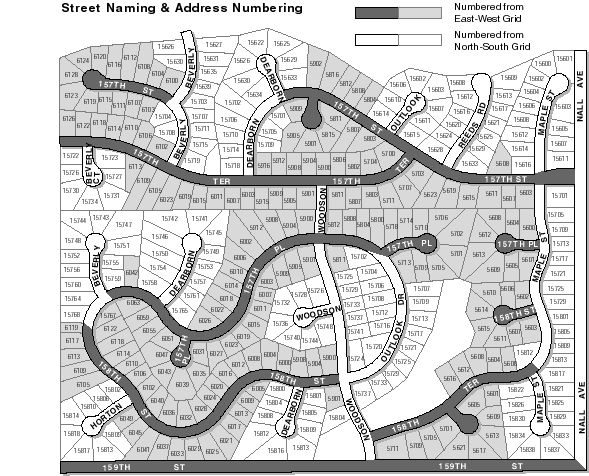Chapter 3 - Assigning Address Numbers
Although assigning an address number to each structure on a particular street seems relatively
straightforward at first glance, it actually poses some of the most difficult addressing problems.
For example, the curvilinear streets and cul-de-sacs found in newer subdivisions create situations
which are far harder to address than the traditional rectangular grid pattern of streets. Strip
shopping centers and office parks often contain multiple buildings that are not in a clearly ordered
sequence and often have the potential for many addresses being assigned in the same address range.
As a result, it is likely that meeting all of the addressing standards suggested below will happen
in some but not all situations. In the remaining cases, address number assignment will involve
compromises between standards. The standards are listed in approximate order of importance, so that
where compromise is necessary the standards near the bottom of the list should be the first to be
considered for noncompliance.
In general, at least one address should be assigned to each habitable structure that is not clearly
accessory to another building or insubstantial in nature (e.g., a detached garage for a single-family
residence probably does not need an address but a commercial parking garage should have an address).
Where a single building has multiple exterior entrances to separate tenant spaces or separate residential
units, then a separate address number should be assigned to each such exterior door. Where a single
building has multiple doors leading to a shared hallway or lobby, then only one address should be assigned.
-
Numeric Sequence
Addresses should always be assigned so that they are in numeric sequence. Where two or more
buildings addressed off of the same street are located in a "stacked" configuration (one
building behind the other), addresses should be kept in sequence within each building (rather
than alternating between buildings) to the greatest degree possible. In addition, the stacked
building closest to the street should generally have lower address numbers than buildings farther away.
-
Odd/Even Numbering (Address Parity)
Addresses should be assigned with odd numbers on the south and east sides of the street and even
numbers on the north and west sides of the street. Since curvilinear street may change direction
for short distances or run at a diagonal, this standard should be applied given the primary
direction of the street.
Addresses on very short cul-de-sacs or "eyebrows" that are not given a separate
street name should be based on the numbering sequence and parity for the perpendicular street that
provides access to the cul-de-sac. This will keep address numbers consistent with this
standard with respect to the perpendicular street that is being used as the basis for addressing,
although with respect to the cul-de-sac it may appear that there are odd or even numbers on
both sides.

-
Sequence Direction
Addresses should get bigger as you travel west and south. Again however, this standard must be
interpreted based on the primary direction of the street. Curvilinear streets may violate this
standard for short stretches provided that they are in compliance with respect to the general
direction of the full street segment. Where compliance with this standard is difficult or
impossible, it may warrant considering a change in the street name at the point where it changes
direction.

-
Consistency with Cross Streets
Since each street in the street name grid has a "hundred block" designation,
addresses should be assigned so that they are consistent with those designations.
Quivira Road, for example, is the 11900 block. Thus, addresses on a numbered street
that intersects with Quivira should be less than 11900 east of Quivira and greater
than 11900 west of Quivira.
-
Consistency with Distance-Based Address Grid
Since there are 16 named streets per mile and 8 numbered street names per mile,
"hundred block" designations should normally change every 330 feet on
an east-west street and every 660 feet on a north-south street. Thus,
addresses can be assigned based on the distance south or west from the nearest
section line. This standard is particularly useful in areas that are largely
undeveloped (and thus don't have many cross streets) or in areas that have existing
streets that are not in the standard street name grid. This standard should
generally be considered to be less important, however, than staying consistent
with the address designations of cross streets (see Standard 4 above).
-
Avoid Duplicate Address Numbers
Where two streets have the same street name but different street types (e.g., 98th Street
and 98th Terrace), the same address number should not be used on both streets. For example,
if addresses for a block on 98th Street are assigned as 13700, 13704, 13708, etc, then
addresses on the corresponding block of 98th Terrace should be assigned as 13703, 13706,
13710, etc. This may help minimize potential service delivery mistakes if there is some
confusion over the street type.
-
Addressing Consistency
Addresses located across the street from each other should be assigned so that they are
nearly equal. Where there are more addresses on one side of the street, addresses assigned
to the other side will need to be more widely spaced so that addressing consistency is
maintained for addresses across from one another.

|